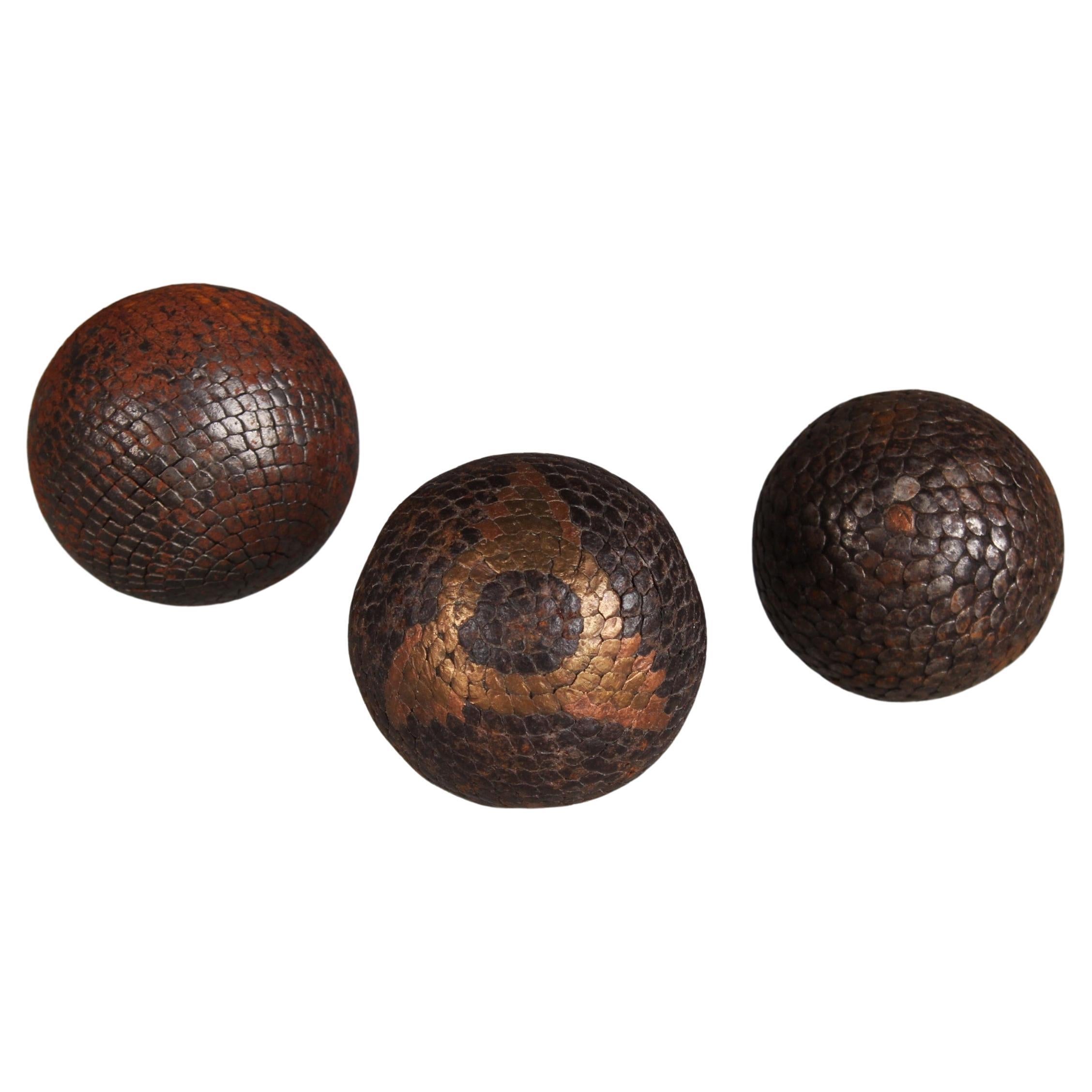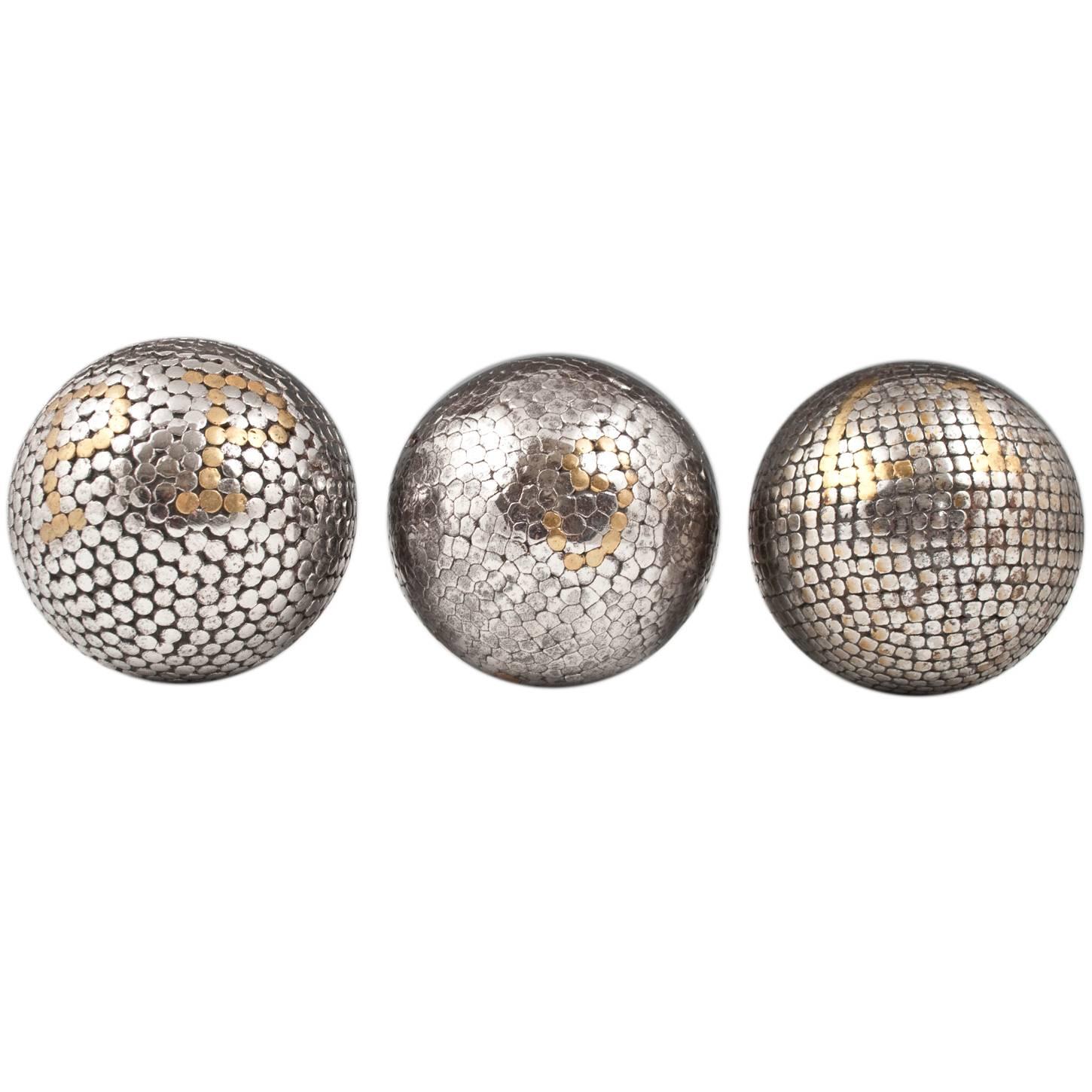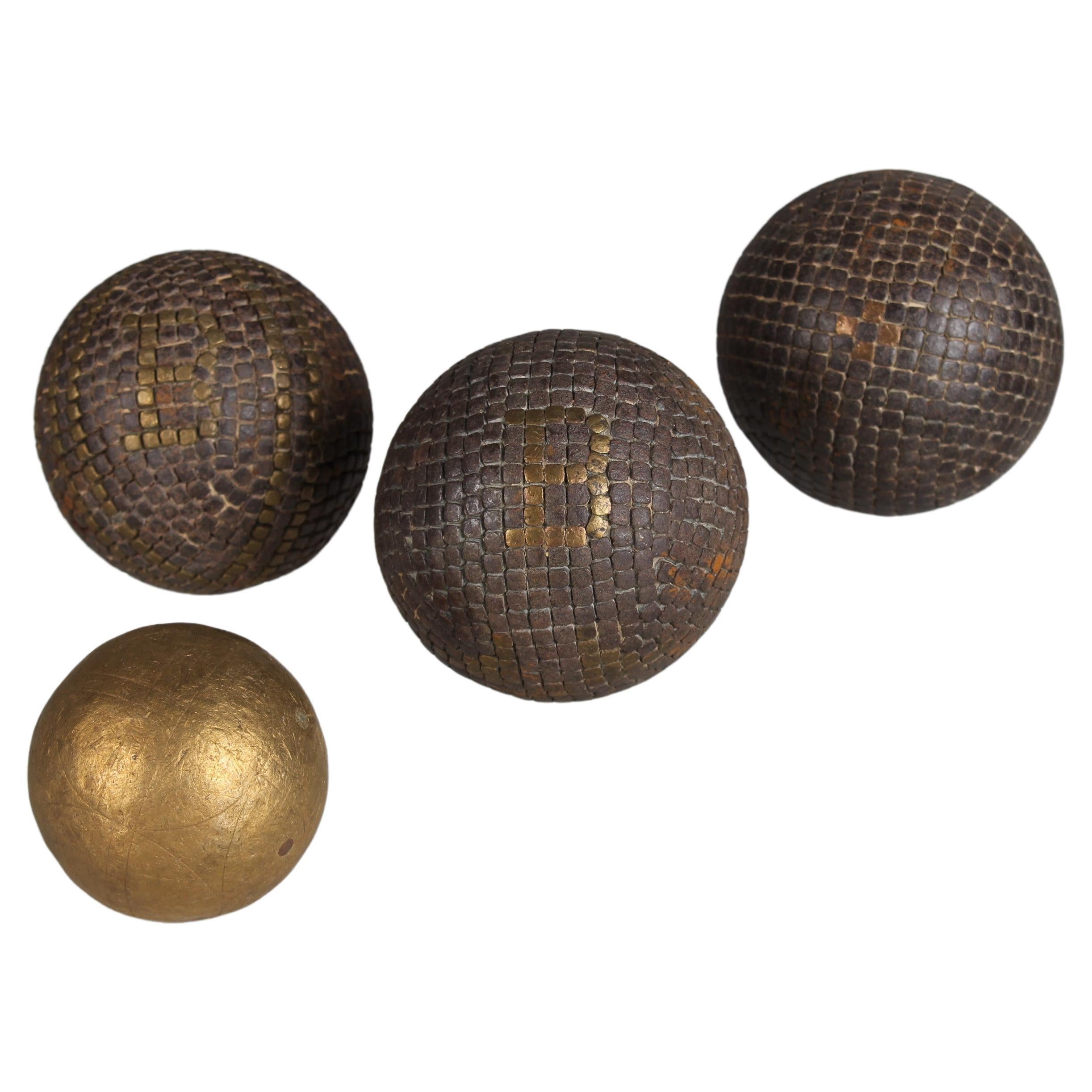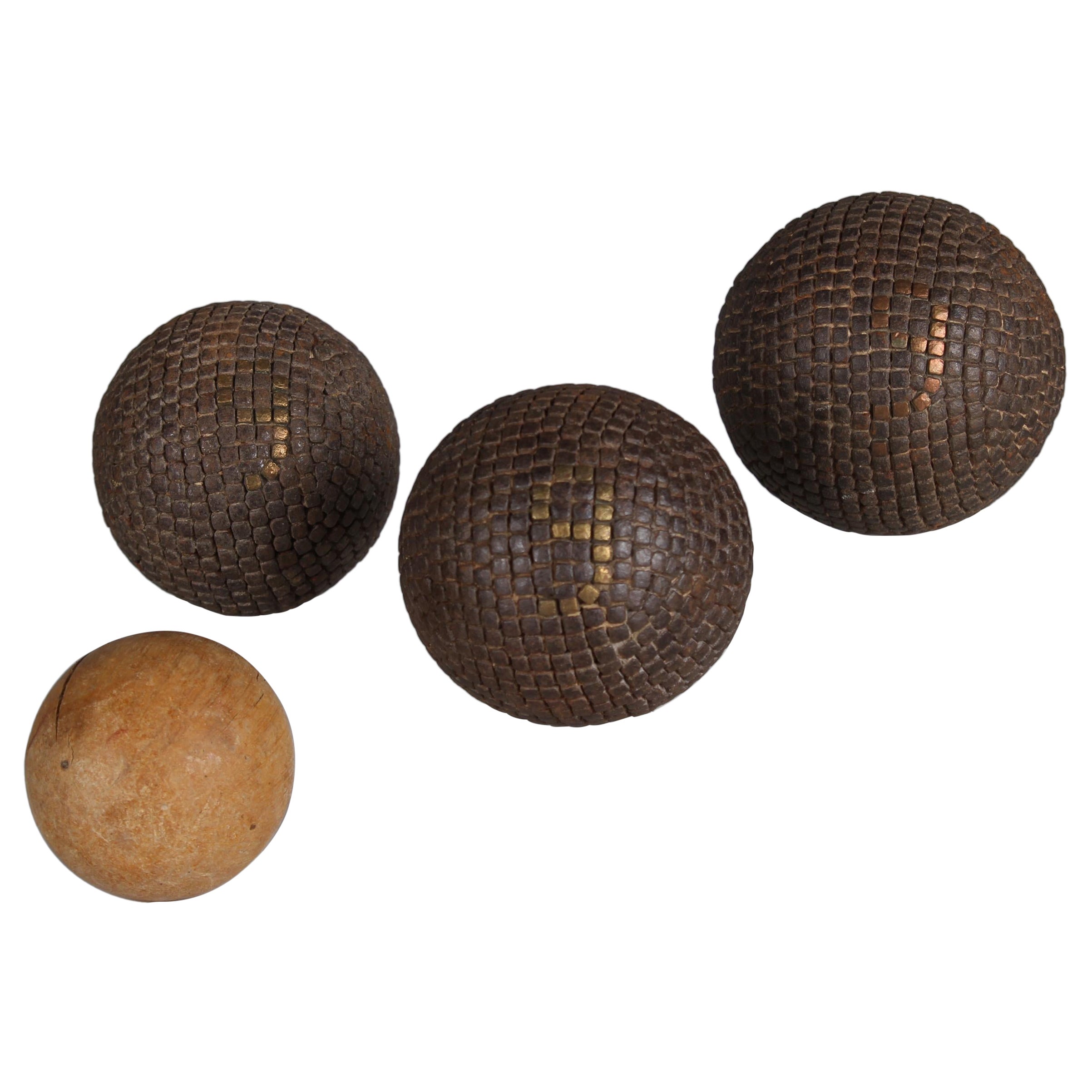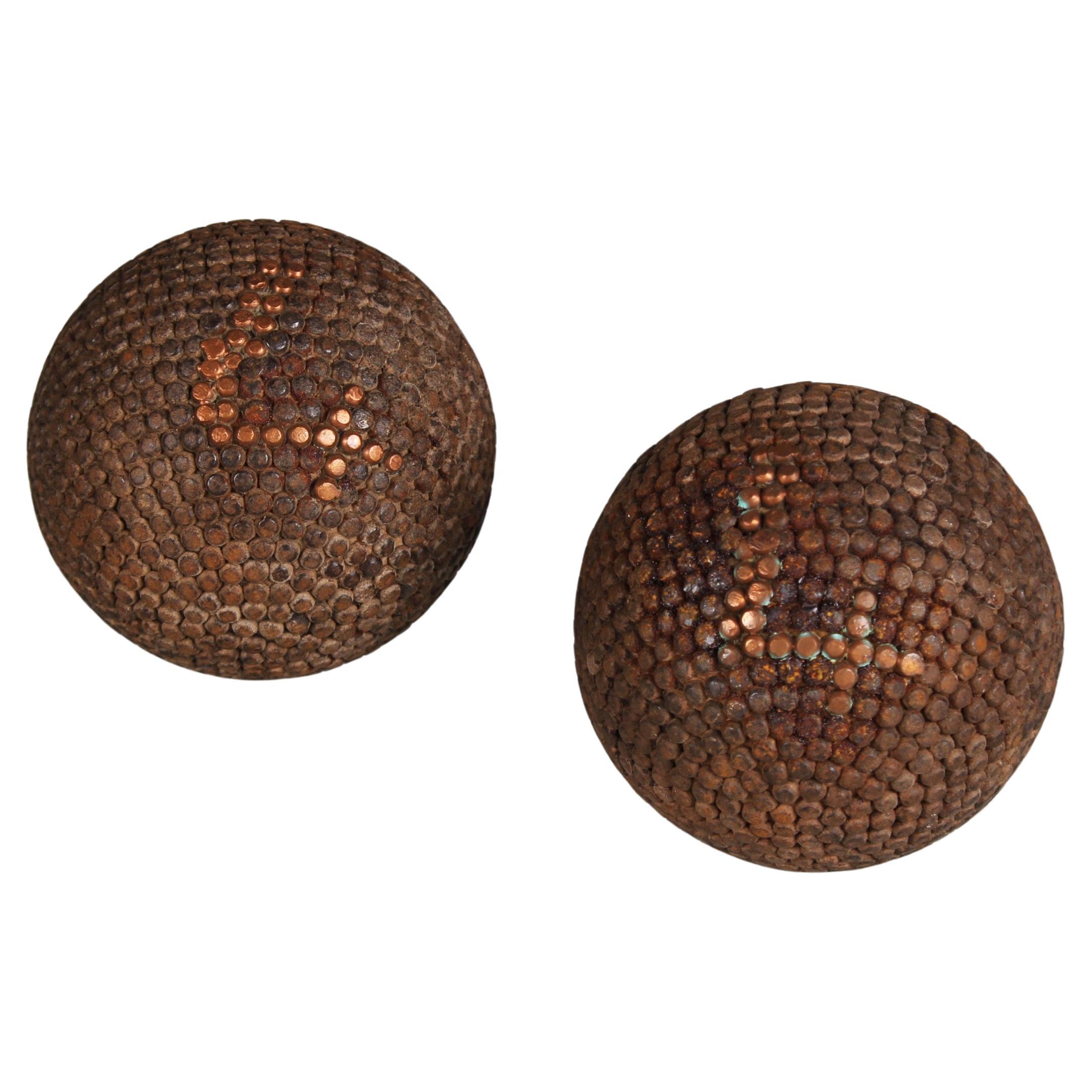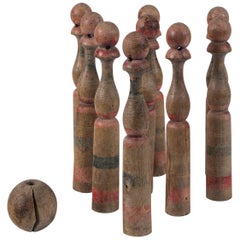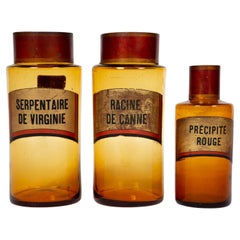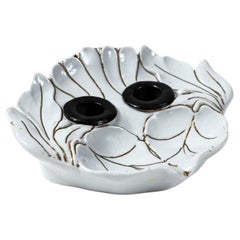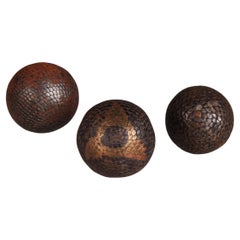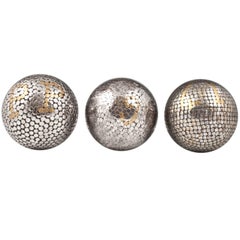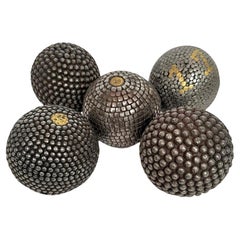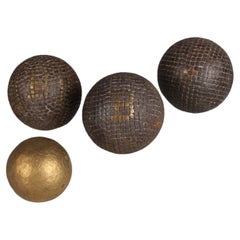Items Similar to Three Antique Petanque Balls, France, Late 19th Century
Want more images or videos?
Request additional images or videos from the seller
1 of 10
Three Antique Petanque Balls, France, Late 19th Century
$975
£739.81
€845.90
CA$1,361.81
A$1,514.15
CHF 790.60
MX$18,430.87
NOK 10,087.77
SEK 9,451.76
DKK 6,313.14
Shipping
Retrieving quote...The 1stDibs Promise:
Authenticity Guarantee,
Money-Back Guarantee,
24-Hour Cancellation
About the Item
Three Antique Pétanque Balls, France, late 19th Century. Solid wood center, covered in hammered, steel nails with accent brass and copper nails. Brass rings as shown are for display. Petanque is the French version of Italian Bocce.
- Dimensions:Height: 3.75 in (9.53 cm)Diameter: 3.75 in (9.53 cm)
- Style:Industrial (Of the Period)
- Materials and Techniques:
- Place of Origin:
- Period:
- Date of Manufacture:Late 19th Century
- Condition:Wear consistent with age and use. Minor losses. Wear consistent with age and use.
- Seller Location:Chappaqua, NY
- Reference Number:1stDibs: LU1150226781872
About the Seller
4.9
Vetted Professional Seller
Every seller passes strict standards for authenticity and reliability
1stDibs seller since 2014
147 sales on 1stDibs
- ShippingRetrieving quote...Shipping from: Chappaqua, NY
- Return Policy
Authenticity Guarantee
In the unlikely event there’s an issue with an item’s authenticity, contact us within 1 year for a full refund. DetailsMoney-Back Guarantee
If your item is not as described, is damaged in transit, or does not arrive, contact us within 7 days for a full refund. Details24-Hour Cancellation
You have a 24-hour grace period in which to reconsider your purchase, with no questions asked.Vetted Professional Sellers
Our world-class sellers must adhere to strict standards for service and quality, maintaining the integrity of our listings.Price-Match Guarantee
If you find that a seller listed the same item for a lower price elsewhere, we’ll match it.Trusted Global Delivery
Our best-in-class carrier network provides specialized shipping options worldwide, including custom delivery.More From This Seller
View AllVintage French Skittle Game 'Jeu de Quilles de Neuf', circa 1920
Located in Chappaqua, NY
Vintage French Skittle Game ‘Jeu de Quilles de Neuf’,circa 1920. Hand painted, turned pins with wonderful aged patina. Complete set of nine pins with orig...
Category
Vintage 1920s French Toys
Materials
Wood
Antique Set of Three Glass Apothecary Jars, 19th Century, France
Located in Chappaqua, NY
Antique Set of Three Glass Apothecary Jars, 19th Century, France. Lovely amber glass with reverse painted labels and red toleware lids. Original paper label on back of Serpentine De ...
Category
Antique Late 19th Century French Art Nouveau Bottles
Materials
Tin
Old Paris Inkwell, France, circa 1900
By Old Paris
Located in Chappaqua, NY
Old Paris Inkwell, France, circa 1900. Art Nouveau foliate design. White porcelain with hand gilt outlines. Original metal inkwells.
Category
Early 20th Century French Art Nouveau Porcelain
Materials
Porcelain
French Opaline Enamelled Glass Vanity Box, Late 19th Century
Located in Chappaqua, NY
French Opaline enamelled glass vanity box, late 19th century. Delicate floral design on black glass with bronze trim.
Category
Antique Late 19th Century French Decorative Boxes
Materials
Opaline Glass
Pair of Cast Iron Footed Planters, France, circa 1900
Located in Chappaqua, NY
Pair of Cast Iron Footed Planters, France, circa 1900. Lovely oblong shape with scrolled top. Overall floral and trellis design.
Category
Early 20th Century French Belle Époque Planters and Jardinieres
Materials
Iron
Antique French Grain Measure, early20th Century
Located in Chappaqua, NY
Antique French grain measure, early 20th century. Aged wood with iron bands and iron handle.
Category
Early 20th Century French French Provincial Planters and Jardinieres
Materials
Iron
You May Also Like
Antique Boule Balls Set "B", Pétanque, 1880s, France, Craftsmanship
Located in Greven, DE
Beautiful, unique Boule set of three Boule balls, France, late 19th Century.
In the 19th century, the manufacture of boules balls underwent significant development in France as the game of boules, particularly the pétanque variant, gained in popularity. The manufacture of boules balls during this period was a manual process that required expertise, precision and love to detail.
In the late 19th and early 20th centuries, particularly in rural areas of France and other Mediterranean regions, olive wood was a commonly used source of material for making boules balls. This was not only due to the availability of the material, but also to the outstanding properties of olive wood, which was characterized by hardness, strength and a rich grain.
First, the olive wood was carefully selected and shaped into raw balls, which were then sanded to the desired size and shape. The nails were then hammered into the balls one by one, making sure that they were evenly distributed and firmly anchored. Finally, the spheres were polished and coated with a protective varnish to enhance their natural beauty and protect them from the elements.
The use of nails to decorate and reinforce olive wood boules was a traditional practice that not only gave the ball a rustic aesthetic, but also improved its durability and contributed to customization. Many balls were made according to the specific requirements and preferences of the players. Nails were driven at regular intervals around the ball, with each nail hole precisely placed so as not to affect the balance and weight distribution of the ball. These nails not only served as a decorative element, but also helped to strengthen the structure of the ball and make it more resistant to the hard knocks and wear and tear during play. Individual engravings or decorations were often applied to the balls to make them unique and identify the player.
Antique boules...
Category
Antique Late 19th Century French Late Victorian Antiquities
Materials
Olive
19th Century Bocce Balls, France, Set of Three
Located in Point Richmond, CA
Late 19th to early 20th century bocce balls, France, set of three
boxwood, iron and brass nails.
The first ball has the letters PP in brass, the second ha...
Category
Antique Late 19th Century French Folk Art Game Boards
Materials
Brass, Iron
collection of 5 Antique French Studded Petanque Game Balls
By Mark Indursky
Located in Stamford, CT
A collection of 5 antique Petanque French studded game balls. Petanque is similar the the Italian game Bocce. These game balls are hand made starting with a wooden core and surrounde...
Category
Antique Early 1900s French French Provincial Abstract Sculptures
Materials
Wood
Antique Boule Balls Set "B", Pétanque, 1880s, France, Craftsmanship
Located in Greven, DE
Beautiful, unique Boule set of three Boule balls and one target ball, France, late 19th century.
In the 19th century, the manufacture of boules balls underwent significant development in France as the game of boules, particularly the pétanque variant, gained in popularity. The manufacture of boules balls during this period was a manual process that required expertise, precision and love to detail.
In the late 19th and early 20th centuries, particularly in rural areas of France and other Mediterranean regions, olive wood was a commonly used source of material for making boules balls. This was not only due to the availability of the material, but also to the outstanding properties of olive wood, which was characterized by hardness, strength and a rich grain.
First, the olive wood was carefully selected and shaped into raw balls, which were then sanded to the desired size and shape. The nails were then hammered into the balls one by one, making sure that they were evenly distributed and firmly anchored. Finally, the spheres were polished and coated with a protective varnish to enhance their natural beauty and protect them from the elements.
The use of nails to decorate and reinforce olive wood boules was a traditional practice that not only gave the ball a rustic aesthetic, but also improved its durability and contributed to customization. Many balls were made according to the specific requirements and preferences of the players. Nails were driven at regular intervals around the ball, with each nail hole precisely placed so as not to affect the balance and weight distribution of the ball. These nails not only served as a decorative element, but also helped to strengthen the structure of the ball and make it more resistant to the hard knocks and wear and tear during play. Individual engravings or decorations were often applied to the balls to make them unique and identify the player.
Antique boules...
Category
Antique Late 19th Century French Late Victorian Antiquities
Materials
Olive
Antique Boule Balls Set "9", Pétanque, 1880s, France, Craftsmanship
Located in Greven, DE
Beautiful, unique Boule set of three Boule balls and one target ball, France, late 19th century.
In the 19th century, the manufacture of boules balls underwent significant development in France as the game of boules, particularly the pétanque variant, gained in popularity. The manufacture of boules balls during this period was a manual process that required expertise, precision and love to detail.
In the late 19th and early 20th centuries, particularly in rural areas of France and other Mediterranean regions, olive wood was a commonly used source of material for making boules balls. This was not only due to the availability of the material, but also to the outstanding properties of olive wood, which was characterized by hardness, strength and a rich grain.
First, the olive wood was carefully selected and shaped into raw balls, which were then sanded to the desired size and shape. The nails were then hammered into the balls one by one, making sure that they were evenly distributed and firmly anchored. Finally, the spheres were polished and coated with a protective varnish to enhance their natural beauty and protect them from the elements.
The use of nails to decorate and reinforce olive wood boules was a traditional practice that not only gave the ball a rustic aesthetic, but also improved its durability and contributed to customization. Many balls were made according to the specific requirements and preferences of the players. Nails were driven at regular intervals around the ball, with each nail hole precisely placed so as not to affect the balance and weight distribution of the ball. These nails not only served as a decorative element, but also helped to strengthen the structure of the ball and make it more resistant to the hard knocks and wear and tear during play. Individual engravings or decorations were often applied to the balls to make them unique and identify the player.
Antique boules...
Category
Antique Late 19th Century French Late Victorian Antiquities
Materials
Olive
Pair Of Antique Boule Balls "4", Pétanque, 1880s, France, Craftsmanship
Located in Greven, DE
Beautiful, unique Boule ball pair, France, late 19th Century.
Diameter 9,4 cm.
In the 19th century, the manufacture of boules balls underwent significant development in France as th...
Category
Antique Late 19th Century French Late Victorian Antiquities
Materials
Olive
More Ways To Browse
Antique Brass And Copper
Antique Copper Nails
Antique Bocce
Bocce Balls
Antique Bocce Balls
Vintage Wood Skis
Gym Equipment
Snooker Table
Vintage Fishing Rod Fishing
Walking Cane Silver Handle
Collectible Surfboards
Used Cricket Ball
1980s Surfboard
Antique Dress Cane
Antique Perth
Cricket Ball
Fishing Reels Used
Space Helmet Vintage
